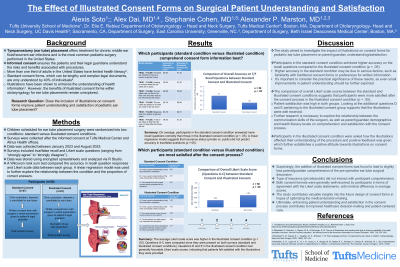Pediatric Otolaryngology
(1035) Impact of Illustrated Consent Forms: Pediatric Tympanostomy Tube Discussion
Monday, September 30, 2024
12:00 PM - 1:00 PM EDT

Disclosure(s):
Alexis V. Soto, N/A: No relevant relationships to disclose.
Alexander P. Marston, MD: No relevant relationships to disclose.
Introduction: Tympanostomy (ear tube) placement addresses chronic middle ear fluid and/or recurrent infections and is the most common pediatric surgery in the US. Limited health literacy among many families raises concerns about the standard informed consent process. This study explores the potential benefits of an illustrated consent form for pediatric ear tube placements, aiming to enhance parent/guardian understanding and satisfaction.
Methods: Institutional review board approval was obtained. Children deemed to be candidates for tympanostomy tube placement within a single pediatric otolaryngology practice were randomly assigned to either the standard or illustrated consent conditions. All consents were completed in English. Surveys collected data between January and August 2023, including true/false recall and Likert scale inquiries. Statistical analysis, using R Studio, involved a Wilcoxon rank-sum test and linear regression.
Results: The standard consent yielded higher recall accuracy (91% vs 88%), emphasizing its effectiveness in promoting understanding (p = 6.01×10−10). Illustrated consent was associated with significantly higher Likert scale scores (p = 2.2e-16). Insurance status (private vs public) did not predict accuracy in true/false questions (p > 0.05).
Conclusions: This study reveals a nuanced relationship between the style of preoperative informed consent and parent/guardian understanding of pediatric tympanostomy tube placement. Standard written consent was superior in promoting understanding, while the illustrated consent was linked to higher satisfaction levels. The non-significant role of insurance variables adds complexity, highlighting the need for a broader exploration of determinants influencing patient comprehension. Acknowledging limitations in sample size, future research should encompass diverse populations and additional factors. In conclusion, this research contributes valuable insight into balancing understanding and satisfaction, emphasizing the need for tailored approaches in pediatric otolaryngological informed consent procedures.

Alexis V. Soto
MS3
Tufts University School of Medicine
Chicago, Illinois, United States
Alexander P. Marston, MD
Assistant Professor
UC Davis Health
Sacramento, California, United States
